2014 Peugeot Partner Tepee pressure
[x] Cancel search: pressurePage 18 of 268
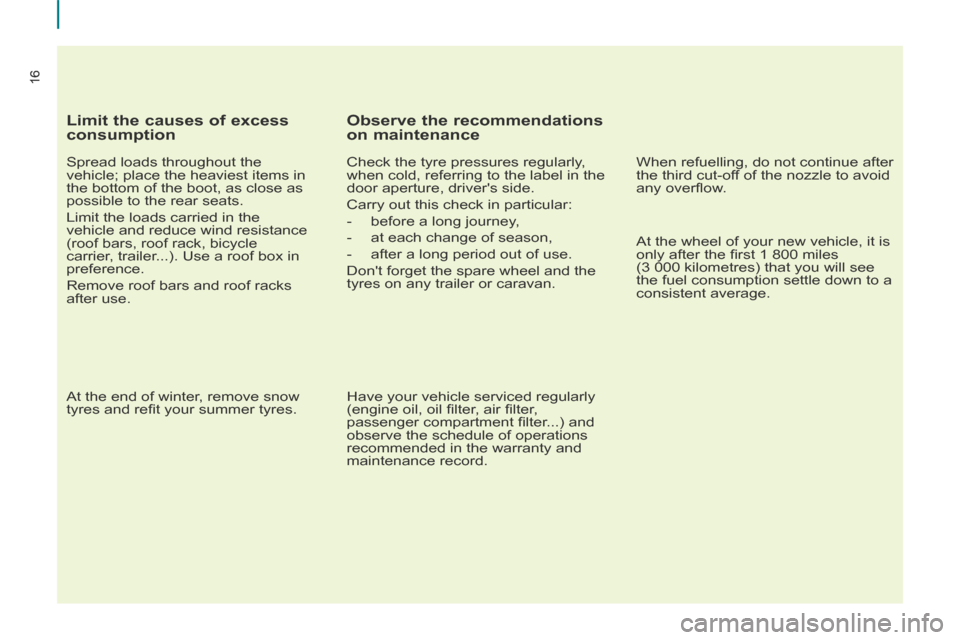
16
16
Limit the causes of excess
consumption
Spread loads throughout the
vehicle; place the heaviest items in
the bottom of the boot, as close as
possible to the rear seats.
Limit the loads carried in the
vehicle and reduce wind resistance
(roof bars, roof rack, bicycle
carrier, trailer...). Use a roof box in
preference.
Remove roof bars and roof racks
after use.
At the end of winter, remove snow
tyres and refi t your summer tyres.
Observe the recommendations
on maintenance
Check the tyre pressures regularly,
when cold, referring to the label in the
door aperture, driver's side.
Carry out this check in particular:
- before a long journey,
- at each change of season,
- after a long period out of use.
Don't forget the spare wheel and the
tyres on any trailer or caravan.
Have your vehicle serviced regularly
(engine oil, oil fi lter, air fi lter,
passenger compartment fi lter...) and
observe the schedule of operations
recommended in the warranty and
maintenance record. When refuelling, do not continue after
the third cut-off of the nozzle to avoid
any overfl ow.
At the wheel of your new vehicle, it is
only after the fi rst 1 800 miles
(3 000 kilometres) that you will see
the fuel consumption settle down to a
consistent average.
Page 31 of 268
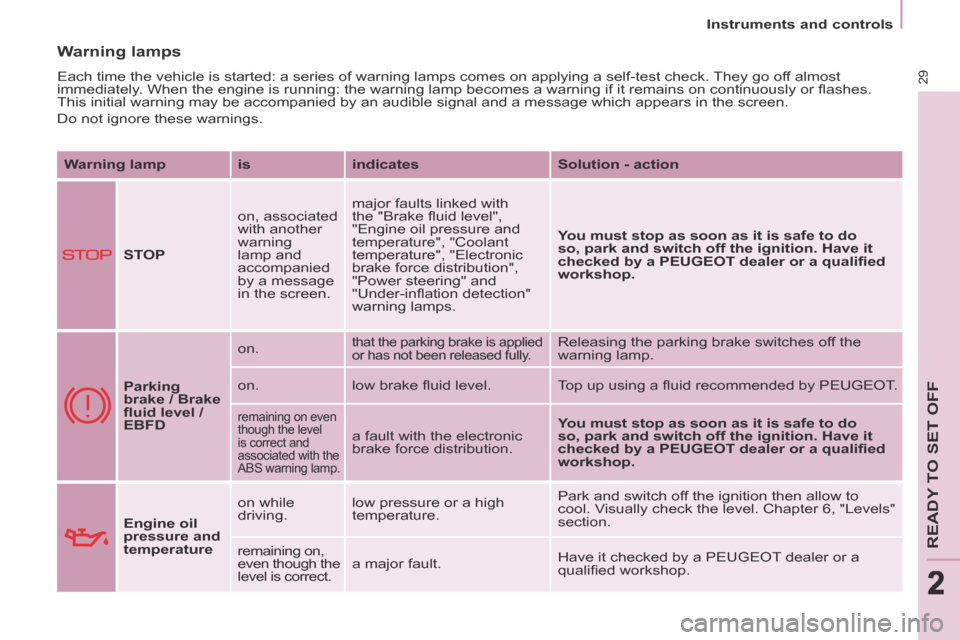
2
Instruments and controls
29
READY TO SET OFF
222
Warning lamps
Each time the vehicle is started: a series of warning lamps comes on app\
lying a self-test check. They go off almost
immediately. When the engine is running: the warning lamp becomes a warning if it remains on continuously or fl ashes.
This initial warning may be accompanied by an audible signal and a messa\
ge which appears in the screen.
Do not ignore these warnings. Warning lamp is indicates Solution - action
STOP on, associated
with another
warning
lamp and
accompanied
by a message
in the screen. major faults linked with
the "Brake fl uid level",
"Engine oil pressure and
temperature", "Coolant
temperature", "Electronic
brake force distribution",
"Power steering" and
"Under-infl ation detection"
warning lamps.
You must stop as soon as it is safe to do
so, park and switch off the ignition. Have it
checked by a PEUGEOT dealer or a qualifi ed
workshop.
Parking
brake / Brake
fl uid level /
EBFD on.
that the parking brake is applied
or has not been released fully. Releasing the parking brake switches off the
warning lamp.
on. low brake fl uid level. Top up using a fl uid recommended by PEUGEOT.
remaining on even
though the level
is correct and
associated with the
ABS warning lamp.
a fault with the electronic
brake force distribution. You must stop as soon as it is safe to do
so, park and switch off the ignition. Have it
checked by a PEUGEOT dealer or a qualifi ed
workshop.
Engine oil
pressure and
temperature on while
driving.
low pressure or a high
temperature. Park and switch off the ignition then allow to
cool. Visually check the level. Chapter 6, "Levels"
section.
remaining on,
even though the
level is correct. a major fault.
Have it checked by a PEUGEOT dealer or a
qualifi ed workshop.
Page 34 of 268
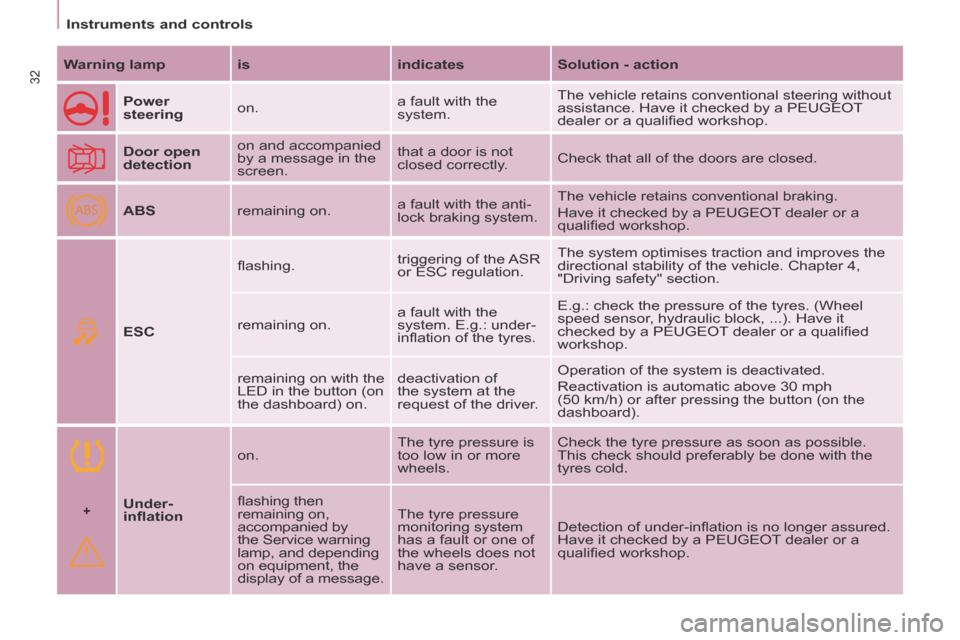
+
ABS
Instruments and controls
32 Warning lamp is indicates Solution - action
Power
steering on. a fault with the
system. The vehicle retains conventional steering without
assistance. Have it checked by a PEUGEOT
dealer or a qualifi ed workshop.
Door open
detection on and accompanied
by a message in the
screen. that a door is not
closed correctly.
Check that all of the doors are closed.
ABS remaining on. a fault with the anti-
lock braking system. The vehicle retains conventional braking.
Have it checked by a PEUGEOT dealer or a
qualifi ed workshop.
ESC fl ashing.
triggering of the ASR
or ESC regulation. The system optimises traction and improves the
directional stability of the vehicle. Chapter 4,
"Driving safety" section.
remaining on. a fault with the
system. E.g.: under-
infl ation of the tyres. E.g.: check the pressure of the tyres. (Wheel
speed sensor, hydraulic block, ...). Have it
checked by a PEUGEOT dealer or a qualifi ed
workshop.
remaining on with the
LED in the button (on
the dashboard) on. deactivation of
the system at the
request of the driver. Operation of the system is deactivated.
Reactivation is automatic above 30 mph
(50 km/h) or after pressing the button (on the
dashboard).
Under-
infl ation on.
The tyre pressure is
too low in or more
wheels. Check the tyre pressure as soon as possible.
This check should preferably be done with the
tyres cold.
fl ashing then
remaining on,
accompanied by
the Service warning
lamp, and depending
on equipment, the
display of a message. The tyre pressure
monitoring system
has a fault or one of
the wheels does not
have a sensor.
Detection of under-infl ation is no longer assured.
Have it checked by a PEUGEOT dealer or a
qualifi ed workshop.
Page 37 of 268
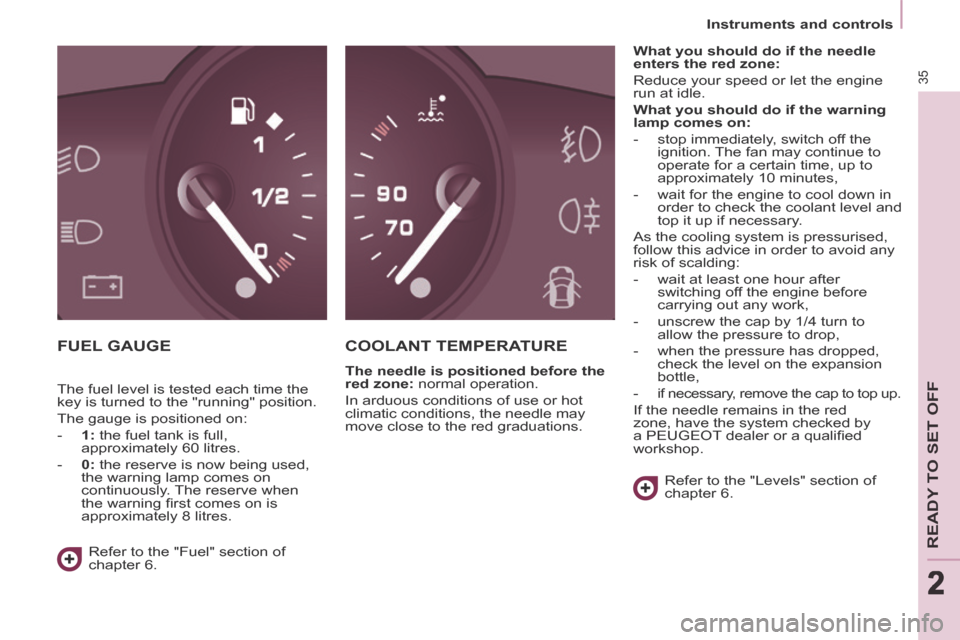
2
Instruments and controls
35
READY TO SET OFF
222
FUEL GAUGE COOLANT TEMPERATURE
The needle is positioned before the
red zone: normal operation.
In arduous conditions of use or hot
climatic conditions, the needle may
move close to the red graduations. What you should do if the needle
enters the red zone:
Reduce your speed or let the engine
run at idle.
What you should do if the warning
lamp comes on:
- stop immediately, switch off the
ignition. The fan may continue to
operate for a certain time, up to
approximately 10 minutes,
- wait for the engine to cool down in order to check the coolant level and
top it up if necessary.
As the cooling system is pressurised,
follow this advice in order to avoid any
risk of scalding:
- wait at least one hour after switching off the engine before
carrying out any work,
- unscrew the cap by 1/4 turn to allow the pressure to drop,
- when the pressure has dropped, check the level on the expansion
bottle,
- if necessary, remove the cap to top up.
If the needle remains in the red
zone, have the system checked by
a PEUGEOT dealer or a qualifi ed
workshop.
Refer to the "Levels" section of
chapter 6.
Refer to the "Fuel" section of
chapter 6.
The fuel level is tested each time the
key is turned to the "running" position.
The gauge is positioned on:
- 1: the fuel tank is full,
approximately 60 litres.
- 0: the reserve is now being used, the warning lamp comes on
continuously. The reserve when
the warning fi rst comes on is
approximately 8 litres.
Page 38 of 268
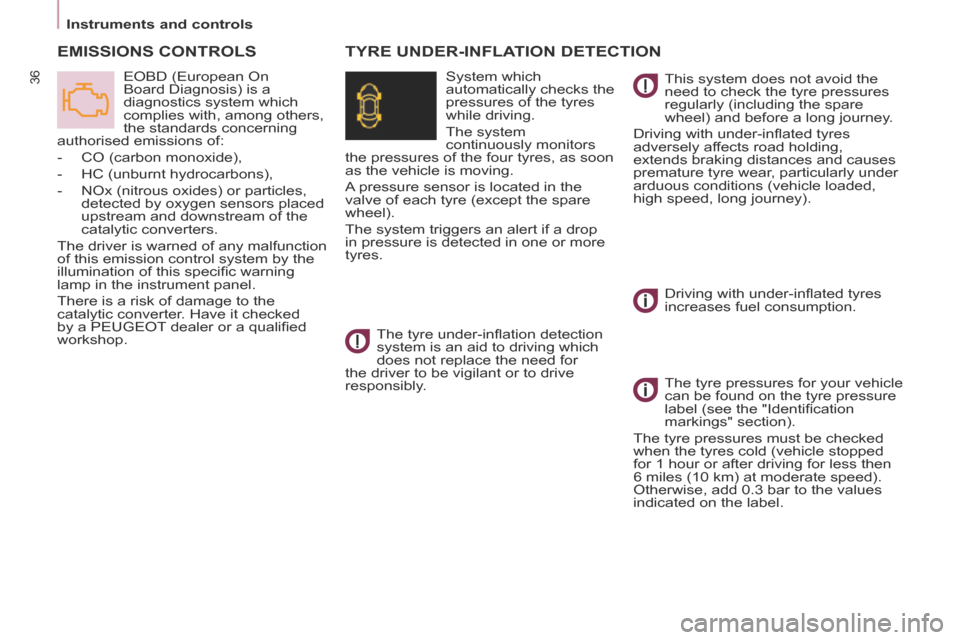
Instruments and controls
36
EMISSIONS CONTROLS
EOBD (European On
Board Diagnosis) is a
diagnostics system which
complies with, among others,
the standards concerning
authorised emissions of:
- CO (carbon monoxide),
- HC (unburnt hydrocarbons),
- NOx (nitrous oxides) or particles, detected by oxygen sensors placed
upstream and downstream of the
catalytic converters.
The driver is warned of any malfunction
of this emission control system by the
illumination of this specifi c warning
lamp in the instrument panel.
There is a risk of damage to the
catalytic converter. Have it checked
by a PEUGEOT dealer or a qualifi ed
workshop.
TYRE UNDER-INFLATION DETECTION
System which
automatically checks the
pressures of the tyres
while driving.
The system
continuously monitors
the pressures of the four tyres, as soon
as the vehicle is moving.
A pressure sensor is located in the
valve of each tyre (except the spare
wheel).
The system triggers an alert if a drop
in pressure is detected in one or more
tyres.
The tyre under-infl ation detection
system is an aid to driving which
does not replace the need for
the driver to be vigilant or to drive
responsibly. This system does not avoid the
need to check the tyre pressures
regularly (including the spare
wheel) and before a long journey.
Driving with under-infl ated tyres
adversely affects road holding,
extends braking distances and causes
premature tyre wear, particularly under
arduous conditions (vehicle loaded,
high speed, long journey).
Driving with under-infl ated tyres
increases fuel consumption.
The tyre pressures for your vehicle
can be found on the tyre pressure
label (see the "Identifi cation
markings" section).
The tyre pressures must be checked
when the tyres cold (vehicle stopped
for 1 hour or after driving for less then
6 miles (10 km) at moderate speed).
Otherwise, add 0.3 bar to the values
indicated on the label.
Page 39 of 268
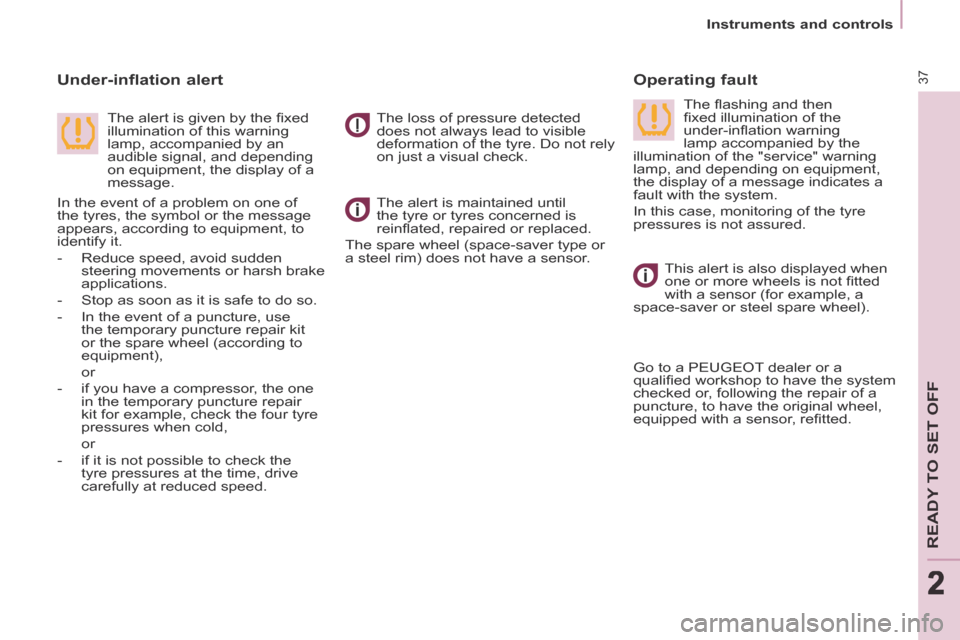
2
Instruments and controls
37
READY TO SET OFF
222
The alert is maintained until
the tyre or tyres concerned is
reinfl ated, repaired or replaced.
The spare wheel (space-saver type or
a steel rim) does not have a sensor.
Operating fault
Under-inflation alert
The loss of pressure detected
does not always lead to visible
deformation of the tyre. Do not rely
on just a visual check.
The alert is given by the fi xed
illumination of this warning
lamp, accompanied by an
audible signal, and depending
on equipment, the display of a
message. The fl ashing and then
fi xed illumination of the
under-infl ation warning
lamp accompanied by the
illumination of the "service" warning
lamp, and depending on equipment,
the display of a message indicates a
fault with the system.
In this case, monitoring of the tyre
pressures is not assured.
In the event of a problem on one of
the tyres, the symbol or the message
appears, according to equipment, to
identify it.
- Reduce speed, avoid sudden
steering movements or harsh brake
applications.
- Stop as soon as it is safe to do so.
- In the event of a puncture, use the temporary puncture repair kit
or the spare wheel (according to
equipment),
or
- if you have a compressor, the one in the temporary puncture repair
kit for example, check the four tyre
pressures when cold,
or
- if it is not possible to check the tyre pressures at the time, drive
carefully at reduced speed. This alert is also displayed when
one or more wheels is not fi tted
with a sensor (for example, a
space-saver or steel spare wheel).
Go to a PEUGEOT dealer or a
qualifi ed workshop to have the system
checked or, following the repair of a
puncture, to have the original wheel,
equipped with a sensor, refi tted.
Page 50 of 268
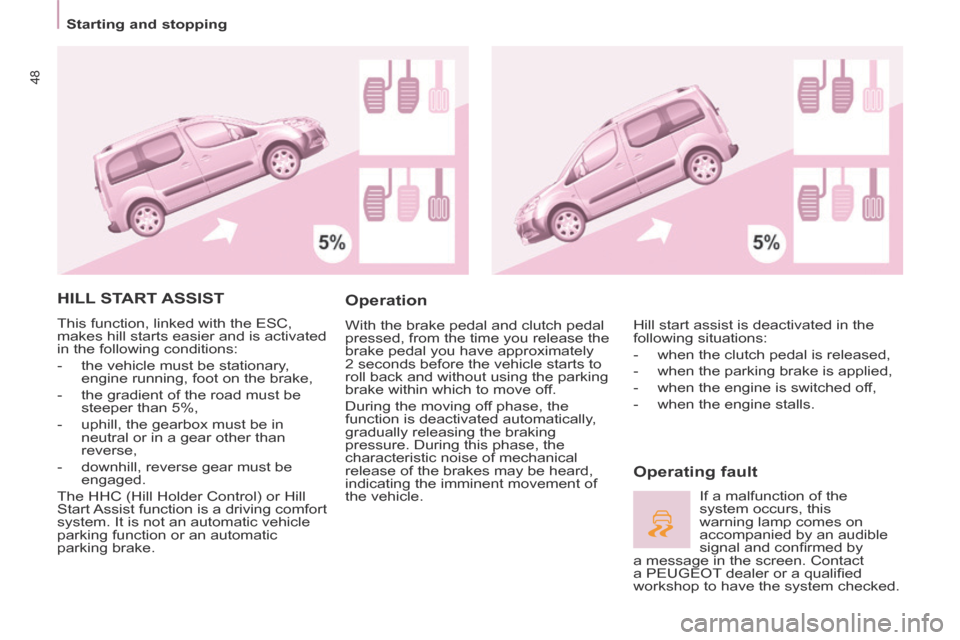
Starting and stopping
48
HILL START ASSIST
This function, linked with the ESC,
makes hill starts easier and is activated
in the following conditions:
- the vehicle must be stationary, engine running, foot on the brake,
- the gradient of the road must be steeper than 5%,
- uphill, the gearbox must be in neutral or in a gear other than
reverse,
- downhill, reverse gear must be engaged.
The HHC (Hill Holder Control) or Hill
Start Assist function is a driving comfort
system. It is not an automatic vehicle
parking function or an automatic
parking brake.
Operation
With the brake pedal and clutch pedal
pressed, from the time you release the
brake pedal you have approximately
2 seconds before the vehicle starts to
roll back and without using the parking
brake within which to move off.
During the moving off phase, the
function is deactivated automatically,
gradually releasing the braking
pressure. During this phase, the
characteristic noise of mechanical
release of the brakes may be heard,
indicating the imminent movement of
the vehicle.
Operating fault
Hill start assist is deactivated in the
following situations:
- when the clutch pedal is released,
- when the parking brake is applied,
- when the engine is switched off,
- when the engine stalls.
If a malfunction of the
system occurs, this
warning lamp comes on
accompanied by an audible
signal and confi rmed by
a message in the screen. Contact
a PEUGEOT dealer or a qualifi ed
workshop to have the system checked.
Page 59 of 268
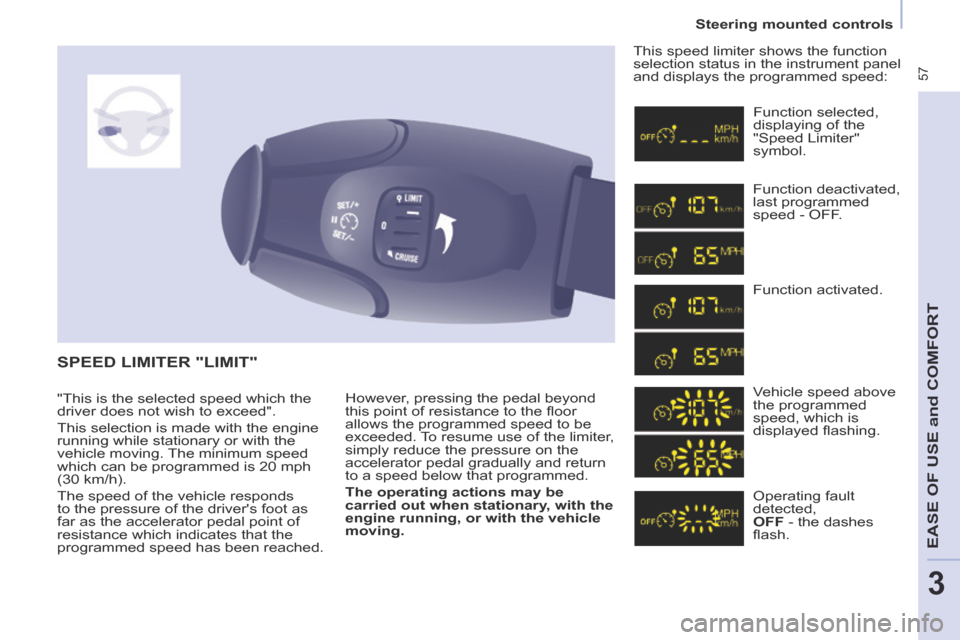
57
Steering mounted controls
EASE OF U
SE and
COMFORT
3
However, pressing the pedal beyond
this point of resistance to the fl oor
allows the programmed speed to be
exceeded. To resume use of the limiter,
simply reduce the pressure on the
accelerator pedal gradually and return
to a speed below that programmed.
The operating actions may be
carried out when stationary, with the
engine running, or with the vehicle
moving. This speed limiter shows the function
selection status in the instrument panel
and displays the programmed speed:
SPEED LIMITER "LIMIT"
Function selected,
displaying of the
"Speed Limiter"
symbol.
Function deactivated,
last programmed
speed - OFF .
Function activated.
Vehicle speed above
the programmed
speed, which is
displayed fl ashing.
Operating fault
detected,
OFF - the dashes
fl ash.
"This is the selected speed which the
driver does not wish to exceed".
This selection is made with the engine
running while stationary or with the
vehicle moving. The minimum speed
which can be programmed is 20 mph
(30 km/h).
The speed of the vehicle responds
to the pressure of the driver's foot as
far as the accelerator pedal point of
resistance which indicates that the
programmed speed has been reached.